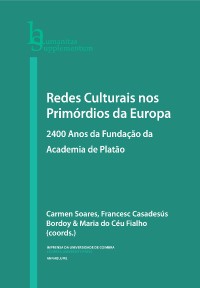Please use this identifier to cite or link to this item:
https://hdl.handle.net/10316.2/38822| DC Field | Value | Language |
|---|---|---|
| dc.contributor.author | Casadesús Bordoy, Francesc | |
| dc.date.accessioned | 2016-03-29T12:05:36Z | |
| dc.date.accessioned | 2020-09-08T22:43:17Z | - |
| dc.date.available | 2016-03-29T12:05:36Z | |
| dc.date.available | 2020-09-08T22:43:17Z | - |
| dc.date.issued | 2016 | - |
| dc.identifier.isbn | 978-989-26-1176-1 | |
| dc.identifier.isbn | 978-989-26-1177-8 (PDF) | |
| dc.identifier.uri | https://hdl.handle.net/10316.2/38822 | - |
| dc.description.abstract | In his effort to separate the immutable and imperishable world of being and truth from the mortal and contingent world, Plato placed somewhere he referred to –in the Phaedrus– as “supracellestial” hyperouranios topos. He thus opened a new space that went beyond even that which was inhabited by the Olympic gods. Even they could only visit it in procession, behind Zeus, together with the cortege of souls that were able to follow him. Because this place was almost inaccessible to human reason it could not be adequately described using the rational language of philosophy or the more imaginative language of poetry. This forced Plato to explore a third avenue in search of the apt terms for describing the sacred sanctuary of being and divine Forms. His solution was to use the mysterious, ritual and initiatic language provided by the Orphic-Pythagorean and Dionysian traditions. With this new use of mysterious language, now transposed in the context of Platonic philosophy, the hyperouranios topos acquired the dimension of sacred and divine space. Its almost supra-divine qualities would have not been conveyed if expressed simply by means of the philosophical logos. Hence, Plato transformed the notions of initiation, purity, and liberation, characteristic of the Oprhic-Dionysian religion, into a new philosophical reality, which was originally alien to this language. In essence, what makes Plato’s description of hyperouranios topos extraordinary is that he was able to overcome the limits of language by creating a new one. In addition to being philosophically rich, this new language afforded a terminology with a strong mysterious flavor enveloped in an attractive poetic form. | eng |
| dc.description.abstract | Platón, en su afán por separar el mundo del ser y la verdad, inmutable e imperecedero, del mundo mortal y contingente, lo situó en el Fedro en un lugar que calificó como “supraceleste”, hyperouranios topos. De este modo abrió un nuevo espacio que supera incluso el que habitan los dioses olímpicos, que tan sólo lo visitan en procesión, encabezado por Zeus, junto con el cortejo de almas que consigue seguirlo. Por este motivo, porque ese lugar resulta prácticamente inaccesible a la razón humana, no puede ser descrito como corresponde ni por el lenguaje racional de la filosofía ni por el más imaginativo de la poesía. Esto obligó a Platón a utilizar una tercera vía mediante el uso de una terminología más adecuada para la descripción del sagrado santuario del ser y las Formas divinas. Para ello recurrió al lenguaje mistérico, ritual e iniciático propio del orfismo-pitagorismo y del dionisismo. Gracias a este nuevo uso del lenguaje mistérico, traspuesto ahora en el contexto de la filosofía platónica, el hyperouranios topos adquiere la dimensión de espacio sagrado y divino, casi supradivino podríamos decir, del que carecería si hubiera sido expresado simplemente con el logos filosófico. De este modo, Platón transformó las nociones de iniciación, pureza y liberación, propias de la religión órfico-dionisíaca, en una nueva realidad filosófica que, en un principio, le resultaba ajena a ese lenguaje. Lo que, en definitiva, hace extraordinaria la descripción platónica del hyperouranios topos es que, para superar los límites del lenguaje, tuvo la capacidad de crear uno nuevo de alto contenido filosófico mediante la introducción de una terminología de fuerte sabor mistérico envuelta por una atractiva forma poética. | por |
| dc.language.iso | spa | - |
| dc.publisher | Imprensa da Universidade de Coimbra | por |
| dc.relation.ispartof | http://hdl.handle.net/10316.2/38821 | por |
| dc.rights | open access | - |
| dc.title | Fedro 247c: Hyperouranios topos, el sagrado y filosófico reino del ser | por |
| dc.title.alternative | Phaedrus 247c: Hyperouranios topos, the sacred and philosophical realm of Being | eng |
| dc.type | bookPart | por |
| uc.publication.collection | Série Humanitas Supplementum | por |
| uc.publication.firstPage | 13 | - |
| uc.publication.lastPage | 22 | - |
| uc.publication.location | Coimbra | por |
| dc.identifier.doi | 10.14195/978-989-26-1177-8_1 | - |
| uc.publication.digCollection | PB | por |
| uc.publication.orderno | 1 | - |
| uc.publication.area | Artes e Humanidades | por |
| uc.publication.bookTitle | Redes culturais nos primórdios da Europa: 2400 anos da fundação da Academia de Platão | - |
| uc.publication.manifest | https://dl.uc.pt/json/iiif/10316.2/38822/206641/manifest?manifest=/json/iiif/10316.2/38822/206641/manifest | - |
| uc.publication.thumbnail | https://dl.uc.pt/retrieve/11104621 | - |
| uc.publication.parentItemId | 54598 | - |
| uc.itemId | 69343 | - |
| item.grantfulltext | open | - |
| item.fulltext | With Fulltext | - |
| Appears in Collections: | Redes culturais nos primórdios da Europa: 2400 anos da fundação da Academia de Platão | |
Files in This Item:
| File | Description | Size | Format | |
|---|---|---|---|---|
| fedro_247c.pdf | 448.83 kB | Adobe PDF |  |
Items in DSpace are protected by copyright, with all rights reserved, unless otherwise indicated.
